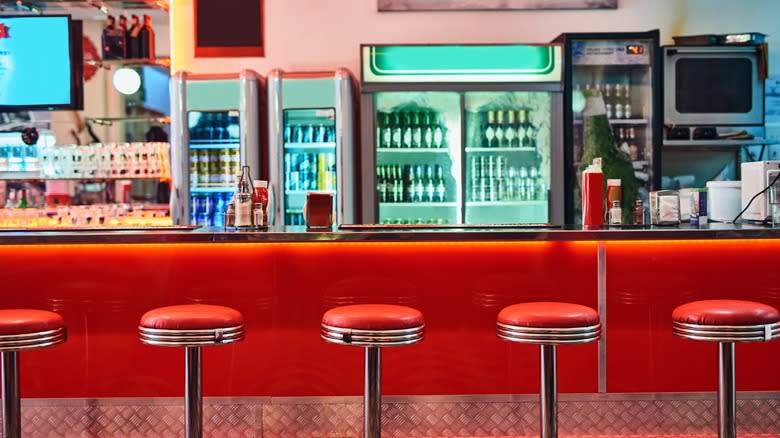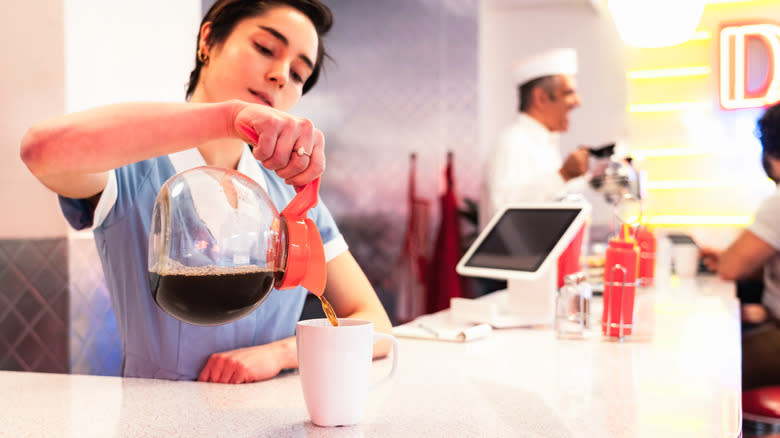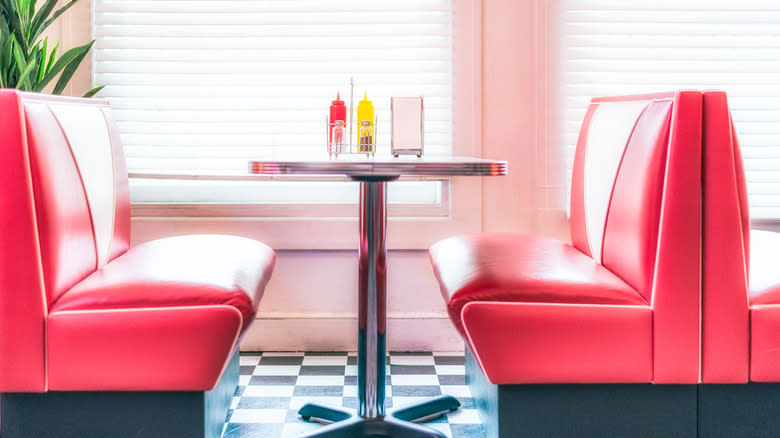The Origin Story Of The Iconic American Diner

Where can you find an entire breakfast menu, a list of milkshakes, and multiple seafood dishes all offered at the same eatery? If you are in America, the answer is, of course, at a classic diner. Known for their lengthy menus and retro decor, diners are a pinnacle of American culture that dates back to the late 19th century. Whether you're a frequent customer at iconic chains like Denny's and Waffle House, or you prefer the hole-in-the-wall diners that know just about everyone who walks through their doors by name, diners are a distinctly American eatery with a fascinating history.
What many consider to be the first diner looked very different from the establishments that customers picture today. Paste Magazine reported that the casual-style eatery was even more casual than you'd ever imagined, looking more like a pushcart than a stationary restaurant. Most diners remained on wheels for over 40 years before finding permanent residences across America.
Read more: The Ultimate Ranking Of The Best Fried Chicken Chains
The First Diners Were On Wheels

Today, stepping into a classic American diner will take you back in time, but early diners were a far cry from the nostalgic establishments we know today with rotating barstools and a neon sign that reads, "Open 24 hours." In fact, the very first diner was actually on a wagon pulled by horses. Businessman Walter Scott opened what would soon be known as the very first diner in 1872 in Providence, Rhode Island, offering customers a variety of sandwiches, pastries, and coffee.
This mobile eatery was massively popular for multiple reasons. Food and drinks were very reasonably priced, attracting a wide array of people with different income levels and social backgrounds. It also allowed people to grab a bite after a long workday without worrying about dress codes or regular business hours. Since its earliest days, diners have been a haven for night owls looking for a late-night bite when other traditional eateries have long since closed for the night. According to Smithsonian Magazine, Scott's "night lunch wagon" attracted high and low class alike, proving that a well-priced hot meal was a great unifier in 19th-century America.
Fast-forward to 1913, when the first diners to trade in their wheels for countertops established themselves along the East Coast. To this day, you can find diners in New York City and New Jersey that have been operating the same way and serving many of the same dishes for over a century.
Diners Evolved Quite A Bit After World War II

The classic American diner has taken on many shapes throughout its history, rapidly evolving to cater to various demographics. Diner owners began to add decor to their establishment's interior after shifting the business model from predominantly male patrons to women during World War I. They also upped their menu to offer more "homestyle" hot meals that resembled foods cooked at home. The diner survived the Great Depression when many upscale restaurants shuttered their doors thanks to diners' low prices that still offered Americans a substantial meal for less. But it wasn't until after World War II that diners evolved into the classic eatery we recognize today.
With many middle-class Americans migrating to the suburbs and looking for eateries that accommodated larger families without costing an arm and a leg, diners were ready to welcome them. By the late 1950s, thousands of diners across America offered families an extensive menu during breakfast, lunch, dinner, and all hours in between. Over the years, certain diners have branched out to become national chains, while others remain true to their mom-and-pop roots. Next time you sit down to order a blue plate special in the wee hours of the morning, you might find yourself feeling extra grateful for the vinyl-covered booths and chrome countertops -- at one point in history, it was merely a horse-drawn wagon.
Read the original article on Daily Meal


